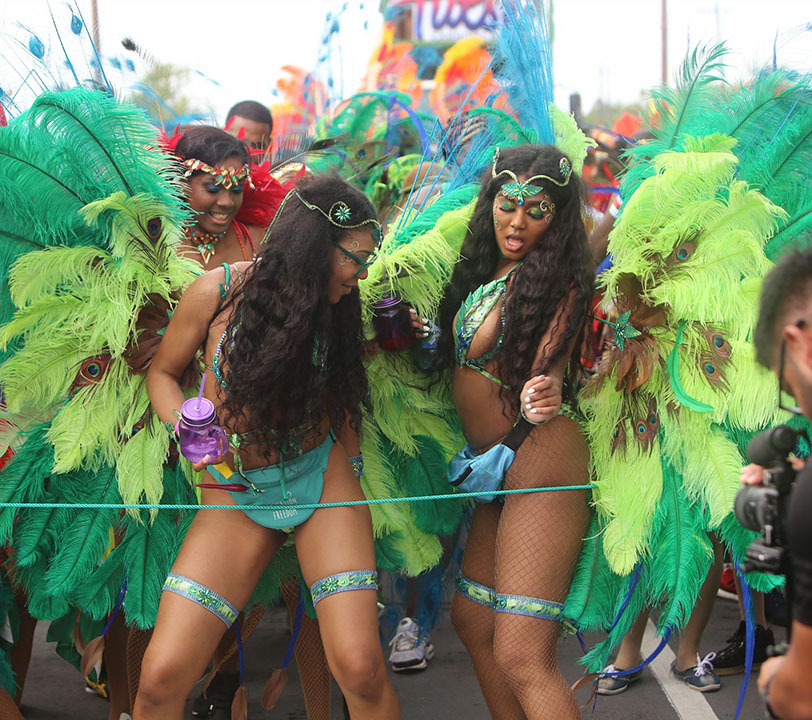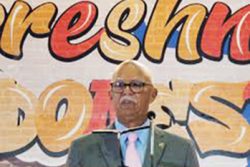 The Guyana Carnival rolled by behind the big trucks from May 17 – 27. It is the newest – or, rather, the most recent – festival to have emerged in the country. It was part of the 53rd independence anniversary celebrations, and as a cultural phenomenon, it deserves a final study and assessment.
The Guyana Carnival rolled by behind the big trucks from May 17 – 27. It is the newest – or, rather, the most recent – festival to have emerged in the country. It was part of the 53rd independence anniversary celebrations, and as a cultural phenomenon, it deserves a final study and assessment.
What is this festival? How important is it to Guyana? What and how does it contribute to the independence anniversary commemoration? What is its form? What shape did it take in 2019? Is it national? What does it do for the nation? How successful was it this year?
Reports in sections of the press lauded it as a resounding success, saying that the crowds of people on the streets “were blown away” by the beauty and spectacle of the carnival bands, and large numbers of visiting tourists were mesmerised. But that evaluation might just be premature as the accuracy of those reports are called into question. Are the affirmative judgments a bit hasty? There are many questions to answer.
It is appropriate to describe carnival as the most recent Guyana festival rather than the newest, because it is not entirely new. It does not have a settled Guyanese form since it is a borrowed festival and an imitation. It has been here before and it has a history. It is instructive to look at that history.
What is this festival and how did it come to Guyana? We have visited this before, but a summary is necessary to put it all in context and to draw conclusions that should be understood by all, including those who did not read the previous accounts.
The Guyana Carnival is a manufactured festival. It did not evolve in Guyana through a process of indigenous traditions but was imported from Trinidad and Tobago to celebrate Guyana’s Independence Day. It is a popular festival, since its most viable dimension is its popular appeal to the masses, that it is mainly driven by the popular culture and its primary purpose is to provide entertainment. Its activities are mostly governed by this objective and have little or no other meaning.
Its other intention is commerce. It is a means of making money; an entrepreneurial venture, taken advantage of by the private sector because there is income to be gained from carnival events, including advertising benefits from association with or involvement in the carnival by way of sponsorship of events. Depending on what they have to sell, companies can look forward to massive sales at festival time. Moreover, they can attach their names, products and images to the fever pitch of the events and impact the minds of the large crowds of revellers.
Carnival can also be used by both the private sector and the government or public sector for purposes of tourism. A commercial festival can serve as a tourism product and hopefully attract large numbers of arrivals into the country with the potential commensurate revenue. This was surely the idea, in addition to its entertainment value, when Jamaica as well as the Bahamas imported the Trinidad carnival. That was also why other West Indian islands which did not have carnival have now imported it.
The Guyana carnival then, is a manufactured, popular and commercial festival, and one may evaluate it along those lines to determine its success. It is an importation of the Trinidad carnival, which is a cultural and traditional festival and one that has deep indigenous, cultural roots. It does not have those in Guyana. It has been here for four years, but traditions take time to develop.
There is a history of carnival in Guyana. British Guiana had cultural traditions that were practiced and were popular in the 1950s and 1960s. These included the steel pan, calypso, floats and float parades on the streets, costumed bands, Band of the Year competitions, Queen of the Bands, beauty contests, and tramping with steel bands on the streets. These were pulled together, fashioned and organised into a carnival in the 1960s.
The independence carnival started in 1966 to celebrate that event was also borrowed from Trinidad. Then in 1970 it was converted into Mashramani, to celebrate Republic Day. It was therefore shifted from May 26 and held on February 23 instead. This continued annually ever since and there was no festival at independence.
There had not been a carnival held in Guyana since 1969, until the government decided to hold one to celebrate the Golden Jubilee on May 26, 2016. Private commercial interests soon saw the possibilities and organisations such as Hits and Jams, Pulse, Kashif and Shanghai, and other groups took it over and carnival became annual in Guyana again. This year, there was a carnival committee headed by Bobby Vieira, which appeared to be an amalgamation of government and the public and private sectors.
What is it really? We can be informed by last month’s festivities. It ran from May 17 to May 27 and was limited in its range of activities. There was a series of J’ouverts, fetes, parties and stage shows; the night clubs thrive during this season. The main driving force is the popular culture, events are shaped by it and designed to appeal to the youthful energies, and fashionable influences. There is heavy imitation of Trinidad, primarily, with the usual Jamaican dance hall influence persisting.
The J’ouverts are commercial events with tags like “Wet Wednesday”, “Stink an’ Dutty” and “Friends with Benefits”. Again, these are imitations from Trinidad. “Wet Wednesday” is a combination of wet fetes and “Machel Wednesdays” in Trinidad, and indeed, Machel Montano is one of the regular drawing cards at the J’ouverts in Guyana. The high point this year was the Buju Banton “I Am Legend – Long Walk to Freedom” mega concert.
There were bands which invited revelers to pay to join. On carnival day, these players followed the big trucks provided by some of the large companies. These bands were supposed to be the main attraction and people lined the route, congregating in various adjacent spaces to lime, picnic and drink to their own music.
It is here that one can begin to assess success or otherwise. But in order to do this, objective data need to be gathered and documented. It is not known whether the carnival committee or the Ministry of Tourism did any of this. However, newspaper reports claimed there were multitudes of tourists. Indeed, there were foreign visitors, but how many? Were any of them really tourists who came in for carnival?
Looks can be deceiving as the saying correctly goes. For instance, how many of these ‘tourists’ were actually in Guyana for business? The new oil industry has brought in quite a few of those. How many of them actually live and work here, like the growing numbers of Brazilians? Many Guyanese resident overseas return home at independence and would still have been here if there were no carnival. This data may be gathered from immigration arrival cards at the airports.
As it stands, observation did not bear out the newspaper claims. Further, contrary to those reports, there was nothing impactful, amazing or spectacular about the costumed bands, unless it was in specific reference to the beauty and attraction of the female form. Young women dominated in the bands, and probably it was their clothes that were “blown away”, since they were not wearing any.
There was indeed revealing spectacle, but all the costumes in all the bands were the same combination of bikini, beads, trinkets and feathers. The designs had little variety, just as has been happening in Barbados’s Crop-Over. Nudity has been an issue in carnival bands, and it has become considerably more popular and prevalent. It is commonplace at the Rio carnival in Brazil. And in Trinidad, nudity became an artistic design when the band “Tribe” made it high fashion at carnival years ago.
Nudity, however, was not the problem in Guyana’s carnival this year. The organisers need to document the statistics, since there were very few bands on the road. How much income did the bands get, since the numbers in most of them were as miniscule as the costumes they wore? There was a handful of men in costume. A modest number of courageous women actually made up the bands.
There were few bands to look at, and the revelers on the streets entertained themselves by other means. Choice of route for the road march has been an issue in Mashramani. Carnival used the same route as Mashramani did this year (it changes often), and half of it was wasted. No one was on the entire long stretch of Carifesta Avenue, and that should never have been the route. The numbers of stalls along the route were far less than usual. The multitudes of people did not turn up until very late afternoon, and they were more interested in the revelry after dark, not the costumed bands.
In fact, the real success of carnival was in the evening after sundown. There was the “last lap” when the trucks returned from D’Urban Park and, ironically, headed for the National Park where the action used to be in the years before the changes, and where it certainly was last Sunday night. Vlissingen Road from Bel Air Park to Lamaha Street exploded with energy and spirit. The parties were there and at the National Park – and those were free.
There are post-colonial ironies about importing a borrowed festival through which to assert your independence and national identity. So, there are questions about carnival’s success. It was generally superficial with a great deal of popular entertainment and revels, but little variety and not much else. There was no tourism to speak of.
The success resided in the popular culture. The Buju Banton concert was the single most successful event. The “last lap” explosion on Sunday night was the zenith of the carnival spirit. But in contrast to the millions made at the Buju affair, how much did the carnival band leaders lose? Was the City Council happy with the reduction in takers – the relatively small numbers of vendors – renting space for stalls along the route?
The stark truth of this may only be known if there is scrupulous collection of accurate data about these things. The tourism authorities, the carnival team, the Department of Culture, need to get that done.








